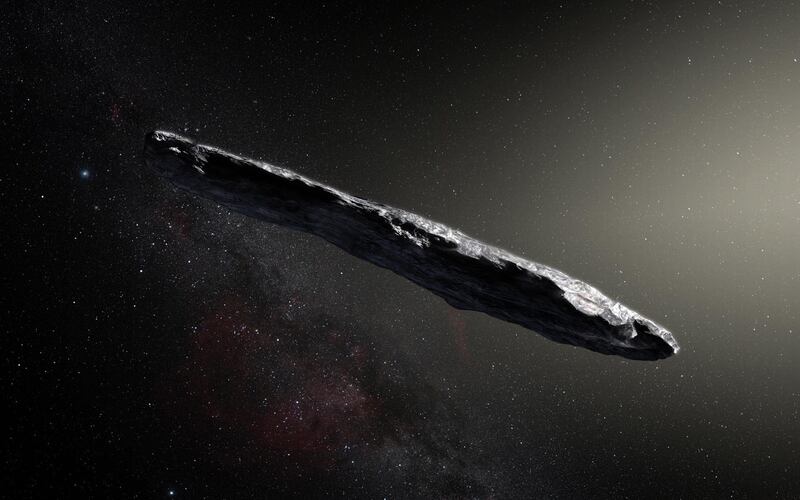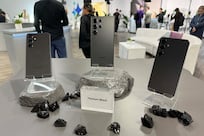As Star Wars fans try to contain their excitement over this week's premiere of The Last Jedi, astronomers are agog at a real-life space drama playing out in our own solar system.
The Earth has just had its first known encounter with an object from another star - and there’s already talk it may have been an alien spacecraft.
The drama began in mid-October, when astronomers in Hawaii detected an incredibly faint object about 33 million km from Earth. At first it seemed like just another chunk of debris left over from the creation of the planets. But as more data came in, astronomers realised the object was like nothing else they had ever seen.
Plotting out its path, they found it had swooped in from the abyss of space in early September, shooting past the sun at an astonishing 315,000 kph and was already heading back out.
Calculations revealed it was on a so-called hyperbolic trajectory, unlike the elliptical paths of ordinary comets and asteroids.
That means the sun’s gravity has never been able to hold on to the object, which must have started its journey in another star system.
This makes 1I/'Oumuamua – as the object is now officially called – the first known visitor from interstellar space.
But astronomers got another surprise when they turned some of the world’s largest telescopes onto the object for a closer look.
They were expecting it to be some kind of comet, one of the myriad piles of dust and ice known to orbit other stars. But ‘Oumuamua appears to be something different. Despite shooting past the sun closer than the planet Mercury, it showed no sign of melting in the heat, and lacked the bright tail of a comet.
Instead, analysis of the sunlight bounced off its surface reveal ‘Oumuamua to be deep red in colour, consistent with long exposure to cosmic rays in deep space, and sometimes seen on asteroids.
But the mystery deepened again when data revealed that ‘Oumuamua is shaped like a long cylinder, around 200 to 400m long and around one-tenth as wide. No known comet or asteroid has such a bizarre shape.
As science fiction buffs quickly pointed out, however, there are striking similarities between 'Oumuamua and the centrepiece of the 1973 novel Rendezvous with Rama by Arthur C Clarke, author of 2001: A Space Odyssey.
In the novel, astronomers detect what they think is an asteroid plunging through the solar system at very high speed – only to discover that its trajectory points to a starting-point among the distant stars.
They then discover that the object – named Rama after a Hindu deity – is cylindrical in shape.
The parallels with ‘Oumuamua aren’t perfect. In the novel, Rama is far bigger at over 50 km long, stubbier and spins rapidly to provide artificial gravity within its capacious interior.
But that hasn’t deterred speculation that the newly-found object shares the same purpose: as an alien star-ship.
And why not? After all, many scientists are perfectly happy with the idea that aliens exist in our galaxy. But ask them if aliens might be present in the solar system, and the question will be met with howls of derision.
The doublethink is partly the result of scientists wanting to keep their distance from the endless wild-eyed claims that UFOs are proof of alien visitation.
Yet some of the supposedly "scientific" arguments against aliens entering the solar system are pretty flimsy.
A standard put-down is that even travelling at the speed of light, it would take thousands of years to cross the galaxy. Yet this presumes knowledge of the technology available to aliens.
Contrary to widespread belief, Einstein’s theory of relativity does not forbid faster than light travel. Indeed, in 1935 Einstein himself explored the possibility of creating “wormholes” in space and time, which could create short-cuts across the galaxy.
Alternatively, the aliens may have chosen to take a more sedate trip around the galaxy in a spacecraft like Rama, which provides a home in space for thousands of years.
Another counter-argument is that aliens would have no reason to visit our solar system out of the myriad others that exist across the galaxy.
This overlooks the fact that FM radio transmissions have been streaming out into space for over 70 years – announcing our existence to the dozens of planetary systems known to exist in our stellar neighbourhood.
The fact is there are no knock-out arguments against ‘Oumuamua being an alien spacecraft. There is, however, a pretty strong reason for not rolling out the red carpet for ET any time soon. It’s based on a mathematical method for making sense of evidence known as Bayes’s Theorem.
This shows we should only get excited about the object being an alien spacecraft if its characteristics are incredibly hard to explain on the basis of any other possibility.
And on the basis of what we know of ‘Oumuamua so far – which admittedly isn’t very much - that’s not the case.
Of course, that would change dramatically if astronomers detected, say, signals coming from the object, or found antennas or other evidence of alien handiwork.
In Clarke’s novel, astronomers resolve the mystery of Rama by sending an unmanned probe to photograph it, revealing its obvious alien nature.
There has been talk about doing the same for ‘Oumuamua, but unfortunately, it seems it’s too late for that. Calculations by Nasa experts suggest the object is travelling too fast to be intercepted using conventional rocket power.
By the end of this month, ‘Oumuamua will be beyond the reach even of the world’s most powerful telescopes, and its true nature will remain forever unknown.
Maybe we should hope it was just an inert chunk of rock. Better that than ‘Oumuamua lives up to its Hawaiian name, - “Scout from the distant past” – and returns accompanied by a Death Star from a galaxy far, far away.
Robert Matthews is Visiting Professor of Science at Aston University, Birmingham, UK






